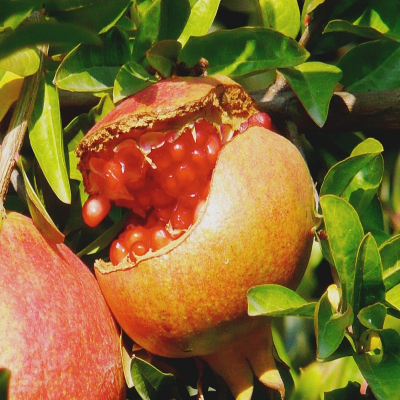Distribution and habitat: Native of Iran, Afghanistan and Baluchistan. It is found growing wild in the warm valleys and outer hills of the Himalaya between 900 m and 1800 m altitude. Cultivated throughout India, the largest area being in Maharastra.
Botany: A large deciduous under shrub with axillary thorns, up to 10 m in height with smooth dark grey bark and often spinescent branchlets;
- Leaves :Opposite, glabrous, minutely pellucid- punctuate, shining above, bright green beneath;
- Flowers: Scarlet red or some times yellow, mostly solitary, sometimes 2-4 together, stamens very numerous inserted on the calyx below the petals at various levels;
- Fruits : Subglobose, crowned by the persistent calyx, rind coriaceous and woody, interior septate with membranous walls containing numerous seeds,
- Seeds: angular with red, pink or whitish fleshy testa.
Chemical constituent:
- Fruit rind gives an ellagitannin named granatin B, punicalagin, punicalin and ellagic acid. Bark contains the alkaloids such as iso-pelletierine, pseudopelletierine, methyl isopelletierine, methyl pelletierine, pelletierine, iso-quercetin, friedelin, D-mannitol and estrone.
- Flowers give pelargonidin-3, 5-diglucoside, sitosterol, ursolic acid, maslinic acid, asiatic acid, sitosterol-b-D-glucoside and gallic acid.
- Seeds give malvidin pentose glycoside. Rind gives pentose glycosides of malvidin and pentunidin.
- Fluoride, calcium, magnesium, vitamin C and phosphate are also reported from fruits.
- Leaves give elligatannins-granatins A and B and punicafolin.
Uses: Used against tapeworm and for strengthening the gums, ophthalmodynia, ulcers, hydrocele, anaemia, pharyngodynia, bronchitis, otalgia, dysentery, vomiting, scabies, splenopathy, hepatopathy
Formulations: Dadimashtaka churna, Dadimadya ghrita, Dadimadya taila
Agrotechnology
Propagation: Seeds, hard wood cuttings, air layering. Mature wood pieces cut into lengths of about 30 cm are planted for rooting.
Harvesting: After 6-7 months from the time of flowering. The fruits are harvested when the skin turns slightly yellow and the fruit gives out a metallic sound when tapped.

